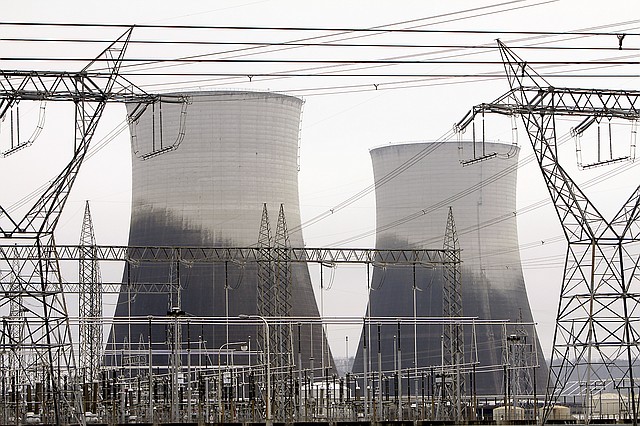TVA argues for tritium production at Sequoyah
Thursday, February 4, 2010
Concerns about protecting groundwater from radioactive tritium leaks while still meeting the demands of a multi-million-dollar Department of Energy weapons contract prompted TVA to make tritium at a second nuclear plant on Chickamauga Lake.
Tennessee Valley Authority spokesman Terry Johnson said each plant -- Watts Bar near Spring City, Tenn., and Sequoyah near Chattanooga -- has release limits for tritium and other radioactive materials.
At Watts Bar, where tritium has been produced for nuclear weapons since 2003, the substance has been found in the reactor's cooling water. In at least one instance in recent years, coolant water at Watts Bar has been spilled or leaked, records show.
PDF: NRS Tritium doc.
Tritium, a key component for American's hydrogen bombs, first was tested in the Watts Bar reactor in 1999, and TVA contracted with the DOE that same year to make tritium at two sites -- primarily Watts Bar and, secondarily, at Sequoyah.
Tritium never has been produced at Sequoyah, but "if we can't meet all needs, we'll start producing it at Sequoyah," Mr. Johnson said.
The nuclear plants are the only two in the nation authorized to double as weapons-grade tritium producers, Mr. Johnson said.
But Nuclear Regulatory Commission records show groundwater sampling in 2005 at Watts Bar found tritium concentrations in a monitoring well on the plant site. At the time, levels topped 13 times the groundwater limit accepted by federal standards, according to NRC records.
Roger Hannah, a spokesman with the Nuclear Regulatory Commission, said he has no information that the NRC ever made recommendations to TVA to spread out its tritium production because of the leaks.
"What we look at is whether they can meet the needs without compromising safety," Mr. Hannah said.
TVA and NRC officials said Wednesday that the groundwater concerns have lessened, and current monitoring shows no tritium levels above EPA's standard for wellwater intended for drinking.
"This is something we constantly monitor ourselves to make sure there is no risk to the public," said TVA Vice President Jack Bailey. "Our releases (of tritium) have been much less than what the safe limits are allowed to be by the regulations."
Making tritium
Since 2003, TVA has received $138 million from the Department of Energy to produce tritium. Jennifer Wagner, a DOE spokeswoman, has said the average annual costs for tritium production are forecast at $56 million per year in the White House fiscal 2011 budget.
TVA's Mr. Johnson said there is "too much variability" to determine what profit the agency ultimately might realize from making tritium.
Tritium is a radioactive isotope of hydrogen. Because its half-life is 12 years, it normally must be replenished in U.S. nuclear weapons, according to national defense officials.
Some of the nation's tritium replenishing needs have been met by salvaging tritium from dismantled U.S. nuclear weapons, but DOE officials have said some tritium production is essential for maintaining the U.S. nuclear weapons stockpile.
To make the tritium, DOE supplies TVA with lithium-filled rods that are placed inside the nuclear reactor in place of some of the reactor's control rods.
The replacements don't harm the ability to control or shutdown a reactor because they do the same job of absorbing neutrons as the regular control rods, Mr. Johnson said. But the lithium, when irradiated by the neutrons, convert to tritium.
When TVA removes the rods to refuel the reactor, the DOE picks them up and transports them to its Savannah River Site, where the tritium can be extracted and purified, Mr. Johnson said.
But both the NRC and TVA have acknowledged that there have been problems with the process.
"The (enhanced rods) did not perform as expected," Mr. Johnson said. "Tritium permeation into the coolant water is greater than expected. It's a process that happens on a molecular level."
Mr. Johnson used the analogy of helium leaking from plastic balloons in a matter of hours because the tiny helium molecules seep through.
The Department of Energy is continuing to work on improving the rods, according to TVA officials.
Tritium, also a normal byproduct of making nuclear power, can be found in some amounts in the coolant water of a plant, though normally not in the concentrated amounts produced in the special tritium production rods, officials said.
TVA's Mr. Bailey said the public shouldn't be worried.
"Tritium itself is one of the least harmful of the radioactive materials that we manage at nuclear plants, but that doesn't mean we don't treat it with a lot of respect," he said.
Staff writer Dave Flessner contributed to this story.
TRITIUM FACTS
* Tritium is a radioactive isotope of hydrogen.
* It is used to boost the explosive power of nuclear weapons.
* It has a half-life of 12 years, which means it decays by about 50 percent in that time.
* It is used to make glow-in-the-dark faces for watches, compasses and other devices
Alex, sr edited; with CTFP archive photos, audio, AP graphic, box (tritium facts), locator maps for Sequoyah and Watts Bar, document (NRC tritium info paper), links and comments

